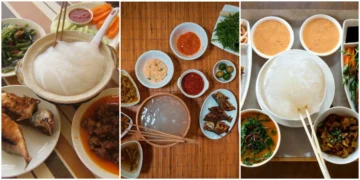Cyprus–a Mediterranean island known for its ancient history, vibrant traditions, and cuisine reflecting a mix of cultures. It is home to one of the world’s beloved cheeses: Halloumi, the best food of Cyprus. This semi-hard brined cheese traditionally produced from goat’s and sheep’s milk blends (or sometimes cow’s milk) has long been revered for its unique texture and exceptional grilling properties and serves as a symbol of Cypriot heritage by representing centuries of dairy craftsmanship, local ingredients, and the island’s warm and generous spirit.
Why Halloumi Is So Delicious?

Halloumi has quickly become one of Cyprus’ favorite foods due to its exquisite sensory experience. With its firm texture and high melting point, grilling or frying makes this cheese ideal for creating a beautifully golden, crispy exterior while maintaining soft yet squeaky interior that tantalizes every time someone bites into it – an experience unlike any other in Cyprus or internationally! Ideal as an appetizer, salad topping or main dish option – Halloumi remains a beloved fixture on local and global menus alike.
Halloumi’s charm goes beyond taste and texture: it is deeply intertwined with Cypriot culture and history. Cheese-making traditions in Cyprus make Halloumi an iconic food staple that symbolizes both pastoral traditions and cultural pride for local communities. Family gatherings, festive celebrations, casual meals – they all use this dish as an integral component in community building & cultural pride building! From seaside tavernas to high-end restaurants alike – Halloumi invites sharing and conversation, embodying “filoxenia”, famed throughout Mediterranean countries!
Ingredients Halloumi (Best Food of Cyprus)
Halloumi’s excellence stems from its carefully chosen ingredients and traditional production techniques:
- Milk: Traditional Halloumi is typically prepared using a combination of goat’s and sheep’s milk; modern versions may also include cow’s milk for variety. Local herds that roam Cyprus’ rugged, sun-kissed landscapes supply high-quality milk that adds its characteristic rich, tangy taste.
- Rennet and Cultures: Natural rennet and specific bacterial cultures are used to coagulate milk into curds that have an ideal texture for pressing and cooking, creating cheese with firm yet slightly elastic textures. This process is essential in creating its unique, firm yet slightly elastic qualities.
- Salt: Once the curds have been made, they are cut, pressed and salted – not only to add flavor but also as part of Halloumi’s unique taste and development.
Halloumi cheese differs from many other cheeses by not being aged for extended periods, instead being submerged in brine to retain moisture and maintain texture. Furthermore, traditional methods involve final heating in hot whey or water which creates its characteristic structure as well as high melting point.
Traditional Techniques: Halloumi production in Cyprus has long been passed down through generations. Artisanal methods ensure each wheel of Halloumi retains the authentic flavor and texture that has made it beloved both locally and worldwide.
Prepare Halloumi (Best Food of Cyprus)

- Slicing: Cheese should typically be cut into 1/2-inch-thick slices to maintain structural integrity when cooking while also permitting heat to create an exquisite caramelized crust on its exterior.
- Grilling or Frying: Halloumi cheese slices are best on either a preheated grill or skillet over medium-high heat. The exterior develops an irresistibly crisp golden-brown crust. The interior remains soft and slightly chewy, enhanced by natural saltiness that intensifies during this process. Plus, its high melting point ensures it remains intact throughout this cooking method!
- Serving Suggestions: In Cyprus, Halloumi cheese is an add on of a meze platter, fresh vegetables, olives and local bread. A squeeze of lemon juice adds brightness to its unique flavors. Halloumi is often a part of salads, sandwiches, or even pizza toppings. This showcases its versatility across traditional and contemporary culinary applications alike.
Why Is Halloumi Unique?
Halloumi stands out as a distinct cheese in many ways. First, its texture sets it apart: firm yet resilient enough to withstand high temperatures without losing its shape. It allows it to grill or fry to perfection with a crispy exterior and soft, creamy interior textures. Furthermore, its unique flavor – an appealing blend of tartiness and saltiness from both its milk base and brining process. This complements many different dishes from simple salads to Mediterranean buffets perfectly.
Halloumi is an icon of Cypriot culture and heritage. Its production methods spanning generations a source of pride for the island. Its celebration forms part of national identity – featured at festivals, markets, and family gatherings. It reminds islanders of their pastoral roots and culinary ingenuity. Sharing Halloumi in vibrant village feasts or modern urban restaurants shows off Cypriot hospitality at its best!
History of Halloumi (Best Food of Cyprus)

The history of Halloumi can be traced back several centuries, its roots firmly planted within Cyprus’s agricultural past. Rural communities relied heavily on dairy farming for sustenance, passing down knowledge about cheese-making through family generations. Over time, Halloumi became its own product influenced by climate, local flora, and traditional techniques unique to Cyprus.
Halloumi has long been an essential staple in Cypriot cuisine. No matter the era or economic condition, its popularity remains constant from rural villages to urban centers. Halloumi remains today as an acclaimed representation of Cypriot culinary tradition.
Real Cyprus Delicacies
- Souvlaki: Skewered meat marinated with herbs and olive oil, typically served alongside pita bread and fresh salad.
- Sheftalia: An authentic Cypriot sausage made of minced pork or lamb mixed with herbs wrapped in caul fat.
- Kleftiko: Slow-cooked lamb marinated with garlic, lemon, and herbs traditionally prepared in a sealed clay oven.
- Tzatziki: Refreshing yogurt-based dip made up of cucumbers, garlic, and mint.
- Meze Platters: These appetizers include dishes such as hummus, tabbouleh, olives, and stuffed grape leaves.
Each dish on this menu enhances Cyprus’ vibrant culinary landscape, providing a dining experience both diverse and steeped in tradition.










Discussion about this post